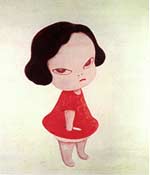by Tim Law
Forty-three years of popular culture (and the absence of popular culture) culminate in the offbeat artwork of Yoshitomo Nara. Yet Nara's plain looking drawings, paintings and sculptures loaded with internal dialogue explaining the generational products of pop are fast becoming pop-culture in their own right. Characterized by ambiguously-ethnic, ambiguously-aged children surrounded by unseen adults, works like "I Don't Mind if You Forget Me" and "In the Deepest Puddle" aren't the indifference of technologically jaded children nor the angsty cries of a generation raised on manga and anime as commonly thought, but simply the reflection of the commonality of loneliness and isolation inherent in childhood. As a child in Aomori, Japan, Nara was sensitive and introverted, staying in to read or draw while the neighborhood kids would play outside. He realized art as the way to express himself after a nude-sketching class in high school and went on to study art at Musashino Art University, earn his master's at the Aichi Prefectural University of Fine Arts and Music and enroll in the Kunst Akademie Düsseldorf. Though his art appears sparse and simplistic, there is a vast technical knowledge guiding a hand that thrives on spontaneity.
"When I make the drawings, I don't think of it. My brush moves unconsciously," says Nara. And the flat, cartoonish girls smoking, carrying knives and looking generally displeased are what come from the unconscious brush. But these images are sometimes confused with aggression. "The children in my works are not aggressive. [With] the knives, [they] can generate power over their lives," Nara said in an interview conducted by Marilu Knode, the University of Wisconsin, Milwaukee's Senior Curator of the Institute of Visual Arts. However, the power these children have is something Nara is losing himself in his popularity. Previously flourishing in art, he further nurtured his creativity in his self-imposed isolation in Germany. "There were no obstacles to think about myself... I was able to see something through my own eyes," Nara explained in a recent publication from the Asahi Shimbun.
But after a rash of exhibitions, several books and even a clothing line, Nara is beginning to see beyond his self and feeling some added pressure because of it. "I fear I am becoming someone else and the popularity is affecting my artistic creativity," he said. "It is natural for human beings to be concerned about others' feelings. Once I recognized people surrounding me, I became concerned about their feelings because I am just an ordinary person." Yet despite the stifling popularity, Nara perseveres. His visions of loneliness and childhood still spontaneously generate into the highly marketable pop art he likens to the music of Kurt Cobain. |
|||||||||||



